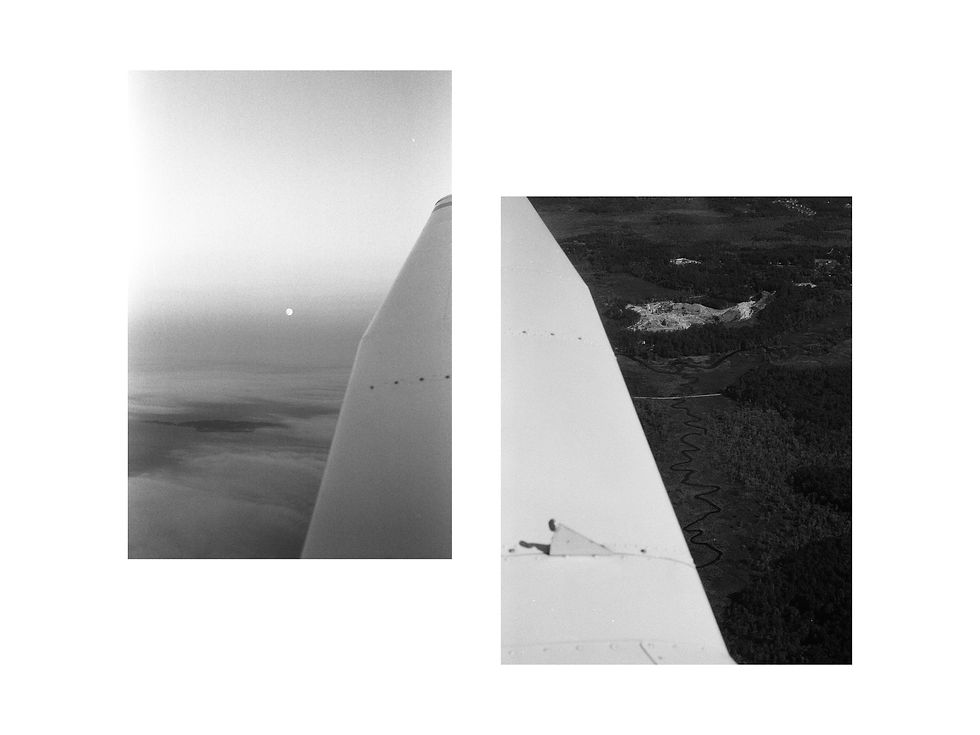Christie Xu
- Anna Lilli Garai
- Jun 26
- 3 min read
Christie Xu works with photography, collage, and analog techniques to reflect on memory, place, and personal history. Growing up in Shenzhen and living across different countries, she often draws from her own experience of movement and change. In works like "A Place On Earth," she brings together aerial images, handwritten notes, and flight maps to piece together quiet, personal views of the world. Her practice stays close to the everyday, focusing on moments that feel both distant and familiar at once.


Q: What drew you to the view from a single-engine plane—was it about perspective, or something more personal?
A: It began with perspective, but quickly became something more layered and intimate. Flying in a single-engine plane means you’re not so far removed from the earth. I feel every shift in weather, hear the engine hum, and see the land without the altitude of detachment. That kind of closeness made me reflect on the fragility of movement, both literal and emotional. There’s a sense of vulnerability in navigating airspace that parallels the feeling of existing between cultures or identities. The project became a way for me to process how we move through space without the assurance of permanence.
Q: How do you relate to the idea of place when it’s always shifting?
A: As someone shaped by diaspora, the idea of place as belonging is not fixed. I found a little bit of myself everywhere I went. I don’t see “place” as a stable background, but as something in motion, marked by memory and emotion. That instability has actually become a foundation in my work. It invites me to stay curious about where I belong and how I make meaning from what’s ephemeral.
Q: "A Place On Earth" blends images, maps, and memory. Did it feel like documenting or more like searching?
A: In the present I was simply documenting. But as I printed these out in the darkroom, I felt more like I was searching for things that had never happened before. As I travel, I like to imagine myself living a completely different life. The images are almost placeholders for feelings—disorientation, longing, fleeting intimacy. It’s about noticing the mundane, the in-between moments that rarely get archived. In that sense, the project operates more like a personal map than a documentary.
It’s less about claiming knowledge and more about honoring what can’t be fully explained.

Q: Do you find flying brings you closer to something, or creates more distance?
A: Both. Flying puts you at a literal distance from the ground, but paradoxically, it made me feel more connected to the idea of self while I was in a transitional state. There's a surrender required in the air: you give up control to forces larger than you. You feel the lightest turbulence and the force of wind when you try to adjust the flaps. That vulnerability opened something in me. It reminded me of the gaps between memory and experience, and how photography can hold space for that ambiguity.
Q: Has your sense of identity changed through moving between countries and landscapes?
A: Absolutely. Moving between countries has fractured and expanded my sense of self. I often feel like I’m translating myself across different cultural systems. There’s grief in that, but also possibility. My identity now feels less like a singular narrative and more like a puzzle of everything I’ve loved—languages, places, and people. That fragmentation shows up in my work, especially in how I use collage and analog processes to echo that multiplicity.
Q: When you think about nostalgia, is it something you lean into—or try to resist?
A: I lean into it, cautiously. Nostalgia can be both illuminating and misleading. It often softens the edges of what was difficult, but it also helps me understand what I’ve lost—or what I’m still looking for. In "A Place On Earth", I was interested in how photography freezes time, and yet always fails to hold it completely. Nostalgia lives in that gap: the ache between remembering and forgetting.


